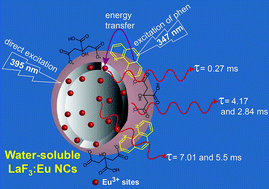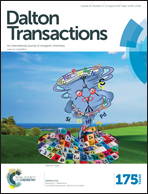Sensitized luminescence from water-soluble LaF3:Eu nanocrystals via partially-capped 1,10-phenanthroline: time-gated emission and multiple lifetimes†
Abstract
Water dispersible citrate-capped LaF3:Eu(5%) nanocrystals (NCs) have been partially surface-functionalized by 1,10-phenanthroline (phen) via a ligand exchange method to produce novel water dispersed citrate/phen-capped LaF3:Eu(5%) NCs in which citrate ligands preserve the water dispersibility of the NCs and phen ligands act as sensitizers of surface Eu3+-dopant sites. The partial ligand exchange and the formation of water dispersed NCs have been monitored by 1H NMR spectroscopy, as well as luminescence measurements at different time intervals during the reaction. These NCs display a distinct phen-sensitized Eu3+-emission profile with enhanced intensity in water as compared to the emission profile and intensity obtained upon direct excitation. Time-resolved (or time-gated) emission spectroscopy (TRES) has been used to probe PL dynamics of Eu3+-sites of LaF3:Eu(5%) NCs by taking advantage of selectively sensitizing surface Eu3+-dopant sites by phen ligands as well as by exciting all the Eu3+-sites in the NCs upon direct excitation. TRES upon direct excitation of the citrate-capped LaF3:Eu(5%) NCs reveals that Eu3+-dopants occupy at least three different sites, each with a different emission profile and lifetime, and emission from purely interior Eu3+-sites has been resolved due to their long lifetime as compared to the lifetime of purely surface and near surface Eu3+-sites. In contrast, the phen-sensitized emission from citrate/phen-capped LaF3:Eu(5%) NCs displays similar emission profiles and lifetimes in TRES measurements, which reveal that phen truly sensitizes purely surface dopant sites of the NCs in water, all of which have nearly the same local environment. The phen-sensitized Eu3+-emission of the NCs in water remains stable even upon addition of various buffer solutions at physiological pH, as well as upon addition of water-miscible organic solvents. Furthermore, the two-photon excitation (λex. = 720 nm) of these water-soluble phen-capped NCs produces bright red Eu3+ emission, which reveals that these NCs are promising for potential applications in biological imaging.


 Please wait while we load your content...
Please wait while we load your content...